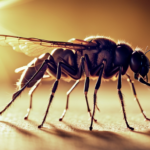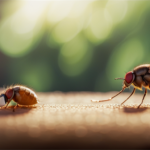Are you experiencing unwanted guests in your residence? Those pesky little insects that buzz around can certainly be a nuisance. But fear not, as I am here to provide you with effective techniques for bidding farewell to these tiny flies.
First and foremost, it is important to identify the type of flies you are dealing with. This knowledge will help you tailor your approach to eliminate them. Once you have identified them, it is crucial to remove any sources of food and moisture that may be attracting them. By doing so, you will significantly reduce their population.
Next, you can turn to natural remedies, such as essential oils and vinegar, to repel these bothersome creatures. Additionally, commercial fly traps and insecticides can be effective in getting rid of them. Regularly cleaning and sanitizing your house will also prevent their return.
Keeping your yard clean and free from debris is another essential step in controlling their presence. Lastly, you can use fly repellents, swatters, and traps as additional measures to combat these tiny flies. If all else fails, it may be wise to consult with pest control professionals who can provide expert advice and assistance.
Say goodbye to those tiny flies and reclaim your home!
Key Takeaways
- Identify the type of tiny flies and remove their food and moisture sources
- Utilize natural remedies such as essential oils, vinegar, and commercial fly traps
- Regular cleaning, sanitizing, and proper food storage help prevent fly infestations
- Take additional measures like using repellents, swatters, and traps, and consult professionals if needed.
Identify the Type of Flies
Now, let’s figure out what kind of pesky little flies have invaded your home.
Different species of flies exhibit different behaviors, making it important to identify them accurately in order to effectively get rid of them.
One common type of fly found in homes is the fruit fly, attracted to ripened fruits and vegetables. They’re small, tan-colored flies with red eyes and are often found near rotting produce.
Another type is the drain fly, which thrives in moist areas like drains and sewers. They’re small, gray flies with fuzzy moth-like wings.
Additionally, there are fungus gnats, which are attracted to damp soil and overwatered plants. They’re tiny black flies that often hover around potted plants.
To catch and identify these flies, you can set up traps using vinegar or fruit juice as bait, or use sticky fly traps.
Once you’ve identified the type of flies infesting your home, you can move on to removing their sources of food and moisture, which’ll help eliminate them for good.
Remove Sources of Food and Moisture
To effectively remove sources of food and moisture, I clean up spills and crumbs immediately after they occur. This prevents flies from being attracted to any leftover food particles.
Additionally, I make sure to fix any leaky pipes and drains to eliminate any standing water that may attract flies.
Lastly, I store my food properly in sealed containers to deny flies access to their food source.
Clean up spills and crumbs
First, make sure you’re not leaving any spills or crumbs lying around, as these can attract those pesky little flies like a magnet. Cleaning techniques and prevention methods are essential in eliminating the presence of tiny flies in your house. Regularly clean up spills and crumbs using appropriate cleaning agents to remove any food sources that may attract the flies. Here are some tips to help you effectively clean up spills and crumbs:
| Cleaning Technique | Prevention Method |
|---|---|
| Wipe up spills immediately | Store food in airtight containers |
| Vacuum regularly | Empty garbage bins regularly |
| Use disinfectant wipes on countertops | Keep kitchen surfaces clean and dry |
| Sweep and mop floors regularly | Fix any plumbing leaks |
By following these cleaning techniques and prevention methods, you will significantly reduce the chances of attracting flies into your home. Next, we will discuss how to fix leaky pipes and drains to further eliminate their breeding grounds.
Fix leaky pipes and drains
Fixing leaky pipes and drains is essential in creating an environment that is less hospitable to those pesky little flies. When pipes or drains are leaking, they create a damp environment that attracts flies and provides them with a breeding ground.
To fix plumbing issues, start by identifying the source of the leak. It could be a loose connection or a damaged pipe that needs to be replaced. Once identified, tighten or replace the affected parts. Additionally, regularly clean and maintain drains to prevent future leaks. This can be done by using drain cleaners or a mixture of vinegar and baking soda.
By fixing leaky pipes and drains, you’re eliminating the moisture that attracts flies and taking a significant step towards getting rid of them.
Now, let’s move on to the next section about storing food properly.
Store food properly
Store your food securely and safely to stave off those bothersome bugs. Proper food storage techniques are crucial in preventing flies from infesting your food. Follow these effective methods to keep your pantry fly-free:
-
Seal containers: Store all dry goods, such as cereals, grains, and flour, in airtight containers to prevent flies from accessing them.
-
Keep fruits and vegetables fresh: Store them in the refrigerator or in sealed bags to avoid attracting flies.
-
Clean up spills promptly: Wipe up any spills or crumbs immediately, as they can attract flies.
By implementing these simple steps, you can significantly reduce the risk of flies infesting your food. With your pantry properly organized, we can now move on to the next section about using natural remedies to get rid of those tiny flies.
Use Natural Remedies
To tackle those pesky tiny flies buzzing around your house, try using natural remedies and homemade solutions. These options aren’t just effective but also safe for you and your family.
One natural remedy you can try is apple cider vinegar. Simply pour some vinegar into a jar and add a few drops of dish soap. The flies will be attracted to the vinegar and get trapped in the soapy solution.
Another option is to make a fruit trap. Place a piece of overripe fruit in a container and cover it with plastic wrap. Poke some small holes in the plastic wrap and watch as the flies are lured in and unable to escape.
Additionally, you can create a fly-repellent spray by mixing equal parts of water and essential oils like lavender or eucalyptus. Spray this mixture around your house to deter flies.
These natural remedies are easy to make and will help keep those pesky flies at bay.
In the next section, we’ll explore the use of commercial fly traps and insecticides for a more comprehensive approach to fly control.
Use Commercial Fly Traps and Insecticides
When it comes to getting rid of tiny flies in your house, it’s important to choose the right fly trap for your needs. There are various types available, such as sticky traps and electric traps, so it’s essential to consider the size of the area you need to cover and the specific type of flies you’re dealing with.
Additionally, it’s advisable to use insecticides as a last resort, as they can be harmful to humans and pets. Instead, focus on preventative measures and natural remedies before resorting to chemical solutions.
Choose the right fly trap for your needs
First, you’ll want to select a fly trap that suits your needs and keeps those pesky flies at bay. Here are three key factors to consider when choosing the right fly trap for your needs:
-
Price vs. Effectiveness: Determine your budget and weigh it against the trap’s effectiveness. Some commercial fly traps may be more expensive but offer better results compared to DIY options.
-
DIY vs. Commercial Options: Decide whether you prefer a do-it-yourself approach or a ready-made commercial trap. DIY traps can be cost-effective but may require more effort to set up and maintain, while commercial traps are convenient but come with a price tag.
-
Type of Trap: Consider the specific type of trap that suits your situation, such as sticky traps, electric zappers, or baited traps. Each trap has its own advantages and disadvantages.
When selecting a fly trap, it’s important to find the balance between price and effectiveness, as well as choosing between DIY and commercial options. Once you have a suitable trap in place, you can then explore using insecticides as a last resort.
Use insecticides as a last resort
As a final option, consider using insecticides sparingly to combat those pesky little pests in your home. However, before resorting to chemical solutions, it’s important to explore alternative methods that are safer for both you and the environment.
DIY fly repellents can be effective in warding off flies without the need for harsh chemicals. You can use natural ingredients such as essential oils, vinegar, or lemon as repellents. These alternatives not only help keep flies away but also leave a pleasant aroma in your home.
Additionally, ensuring proper sanitation and cleanliness in your house will further discourage flies from breeding and infesting your space. By regularly cleaning and sanitizing your surroundings, you can create an environment that’s unwelcoming to flies.
This will be discussed further in the next section on how to clean and sanitize your house.
Clean and Sanitize Your House
To effectively get rid of tiny flies in your house, start by cleaning and sanitizing your living space. Have you ever wondered how clean your house really is? Maintaining a clean and hygienic environment is crucial in keeping these pesky flies at bay.
The first step is to ensure proper ventilation throughout your home. Good airflow helps to deter flies from entering and breeding in your living space. Additionally, consider using essential oils known for their repellent properties. Flies dislike scents like lavender, eucalyptus, and peppermint. A few drops of these oils in a spray bottle with water can be used to create a natural fly deterrent.
Remember to clean your house thoroughly, paying attention to areas where flies tend to gather, such as garbage bins and kitchen counters. Dispose of trash regularly, and keep food covered to minimize fly attraction. Finally, seal entry points to prevent flies from entering your home.
By taking these simple yet effective measures, you can significantly reduce the presence of tiny flies in your living space.
Transitioning into the next section, let’s explore how to seal entry points to further eliminate these bothersome pests.
Seal Entry Points
One way you can effectively eliminate those pesky little insects from invading your home is by sealing any entry points they may use to gain access. To do this, follow these steps:
-
Identify potential entry points: Carefully inspect your house for any small cracks or gaps that flies could use to enter your home. Common entry points include gaps around windows and doors, openings around utility pipes and vents, and cracks in the foundation or walls.
-
Use caulk or weatherstripping: Once you’ve identified the entry points, use caulk or weatherstripping to seal them off. Apply caulk to small cracks and gaps, making sure to fill them completely. For larger gaps, use weatherstripping to create a tight seal.
-
Pay attention to windows and doors: Make sure your windows and doors have tight-fitting screens and are properly sealed. Repair any damaged screens and use weatherstripping to seal gaps around the edges.
-
Don’t forget about utility openings: Check for any openings around utility pipes and vents. Use caulk or expanding foam to seal these gaps.
By sealing these entry points, you can significantly reduce the number of flies that enter your home. Once you’ve completed this step, you can move on to the next section about keeping your yard clean.
Keep Your Yard Clean
To keep your yard clean and prevent the presence of tiny flies, it’s important to prioritize a few key points.
Firstly, remove any standing water in your yard as it serves as a breeding ground for these pests.
Secondly, trim vegetation and remove debris regularly to eliminate potential hiding spots for flies.
Lastly, make sure to keep your trash bins tightly sealed to prevent flies from being attracted to the odors.
By following these steps, you can effectively maintain a clean yard and minimize the presence of tiny flies.
Remove standing water
Start by checking all the sinks and drains in your house for any stagnant water, as these can act as breeding grounds for those pesky flies. Remove any standing water you find by unclogging or repairing the drains.
Additionally, make sure to empty and clean any containers or pots that may have accumulated water, such as flower vases or bird baths. To prevent breeding, eliminate breeding sites by covering or filling in any areas where water tends to collect, such as low spots in the yard or uneven pavement.
Remember to clean and maintain gutters and downspouts to avoid water buildup. By taking these measures, you can significantly reduce the number of flies in your house.
Transitioning into the next section, it’s also important to trim vegetation and remove debris to further minimize fly infestations.
Trim vegetation and remove debris
Maintaining a well-groomed outdoor space with trimmed vegetation and debris-free areas is crucial in keeping your surroundings unappealing to those bothersome insects.
Pruning shrubs regularly is an effective way to prevent tiny flies from breeding and thriving in your yard. By trimming back overgrown branches and foliage, you eliminate potential hiding spots and breeding grounds for these pests.
Additionally, it’s essential to eliminate standing water in your outdoor areas. Tiny flies are attracted to stagnant water, as it provides them with a suitable environment for reproduction. Regularly check for any sources of standing water, such as birdbaths, clogged gutters, or poorly drained flower pots, and remove or fix them promptly.
By implementing these measures, you can significantly reduce the population of tiny flies in your surroundings. To further prevent their entry into your house, keep trash bins tightly sealed, ensuring a seamless transition into the subsequent section.
Keep trash bins tightly sealed
One way to ensure that bothersome insects stay away from your surroundings is by tightly sealing your trash bins. Regularly cleaning your trash bins is of utmost importance in preventing the infestation of tiny flies in your house. Accumulated food residue and waste can attract flies, so it’s crucial to clean the bins thoroughly with hot soapy water and disinfectant.
Additionally, using odor neutralizing trash bags can provide added benefits. These bags are designed to neutralize unpleasant odors, which can further deter flies from being attracted to your bins. By keeping your trash bins tightly sealed, regularly cleaned, and using odor neutralizing trash bags, you can significantly reduce the presence of tiny flies in your house.
Transitioning into the subsequent section about ‘use fly repellents’, it’s essential to explore additional measures to keep these pests at bay.
Use Fly Repellents
Tackle those pesky flies head-on by using fly repellents to keep them away from your home! There are several fly repellent options available, both commercial and DIY.
Commercial repellents often come in the form of sprays or aerosols that can be applied directly to areas where flies are commonly found. These repellents usually contain chemicals that repel flies, such as DEET or picaridin. It’s important to follow the instructions on the product label and use them in well-ventilated areas.
If you prefer a more natural approach, there are DIY fly repellents you can make at home. One option is to mix equal parts water and vinegar in a spray bottle and apply it to areas where flies are present. Flies are repelled by the smell of vinegar. Another option is to make a mixture of essential oils like eucalyptus, lavender, or peppermint with water and spray it around your house. Flies dislike the strong scent of these oils.
Using fly repellents can be an effective way to keep flies at bay, but it’s important to remember that they’re not a long-term solution.
In the next section, we’ll explore other methods, such as using fly swatters and traps, to further combat these annoying pests.
Use Fly Swatters and Traps
If you’re looking for a hands-on approach to deal with those bothersome flies, why not give fly swatters and traps a shot? They can be effective tools in eliminating tiny flies from your house. But which one is more effective, fly swatters or fly traps? Let’s compare them in the table below:
| Fly Swatters | Fly Traps |
|---|---|
| Requires manual effort | Passive trapping |
| Immediate results | Takes time to catch flies |
| Can be messy | Clean and hygienic |
| Limited range | Covers a larger area |
Both fly swatters and fly traps have their pros and cons. While fly swatters require manual effort and can be messy, they provide immediate results and can target specific flies. On the other hand, fly traps are passive and clean, but they take time to catch flies and cover a larger area.
If you prefer a DIY approach, there are homemade solutions for getting rid of tiny flies. You can make a simple trap using apple cider vinegar, dish soap, and a plastic container. The flies are attracted to the vinegar, get trapped in the soapy water, and eventually drown. Other homemade traps include using a mixture of sugar and water or a soda bottle with a funnel.
Now that you know the options for dealing with tiny flies using fly swatters and traps, let’s explore the next step: consulting with pest control professionals.
Consult with Pest Control Professionals
Consider reaching out to pest control professionals for expert advice and assistance in addressing your fly infestation. They have the knowledge and experience to effectively deal with these tiny pests and help you regain control of your home.
Here are some alternative methods for pest control that the professionals may discuss with you:
-
Chemical treatments: Pest control professionals can recommend and apply appropriate insecticides to control fly populations. These treatments are designed to target flies while minimizing any potential risks to humans and pets.
-
Fly baits and traps: Professionals may suggest using baits and traps to attract and eliminate flies. These products are specifically designed to lure flies and prevent them from reproducing, helping to reduce their population.
-
Integrated Pest Management (IPM): Pest control professionals may also discuss the importance of regular maintenance in preventing fly infestations. IPM involves a combination of proactive measures such as sealing entry points, removing potential food sources, and maintaining proper sanitation to deter flies from entering your home.
By consulting with pest control professionals, you can receive expert guidance on the most effective and safe methods to eliminate the tiny flies in your house. They can also provide valuable advice on preventing future infestations through regular maintenance practices.
Frequently Asked Questions
Can I use vinegar to get rid of tiny flies in my house?
Yes, vinegar can be an effective natural remedy for fruit flies. It can be used to trap and kill them. To prevent tiny flies in the house, keep your kitchen clean and dispose of ripe fruits and vegetables properly.
How do I identify the specific type of tiny flies infesting my house?
To identify the specific type of tiny flies infesting your house, look for common signs of fly infestation such as their presence in large numbers, their small size, and their characteristic buzzing sound.
Are there any natural remedies that specifically work for fruit flies?
Yes, there are natural remedies that are effective for fruit flies. Some options include creating a vinegar trap, using fruit fly traps, and maintaining cleanliness to prevent their breeding.
Can I use fly swatters and traps as a long-term solution to get rid of tiny flies?
Fly swatters and traps alone are not effective long-term solutions to eliminate tiny flies in the house. However, incorporating vinegar as a natural remedy can help in getting rid of these pesky pests.
When should I consult with pest control professionals for help with a tiny fly infestation in my house?
I should consult with pest control professionals when dealing with a tiny fly infestation in my house. They have the expertise and tools to effectively eliminate the problem and ensure it doesn’t return.
Conclusion
In conclusion, getting rid of tiny flies in your house can be a daunting task, but with the right strategies, it can be accomplished.
By identifying the type of flies and removing sources of food and moisture, you can prevent their infestation.
Using natural remedies, commercial fly traps, and insecticides can also prove effective.
It’s crucial to clean and sanitize your house regularly and keep your yard clean to discourage flies.
Using fly repellents, swatters, and traps can provide immediate relief.
For persistent problems, consulting with pest control professionals is recommended.
Now, take charge and bid those pesky flies farewell!
Hi, I’m Emma. I’m the Editor in Chief of Tiny House 43, a blog all about tiny houses. While tree houses are often associated with childhood, they can be the perfect adult retreat. They offer a cozy space to relax and unwind, surrounded by nature. And since they’re typically built on stilts or raised platforms, they offer stunning views that traditional homes simply can’t match. If you’re looking for a unique and romantic getaway, a tree house tiny house might just be the perfect option.
















